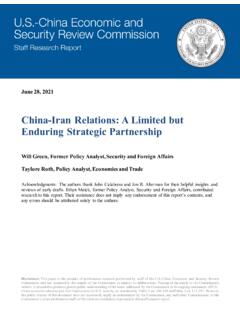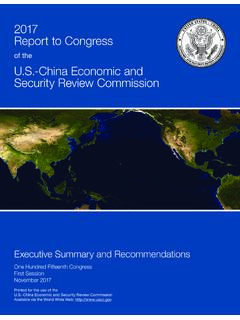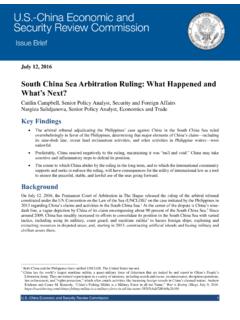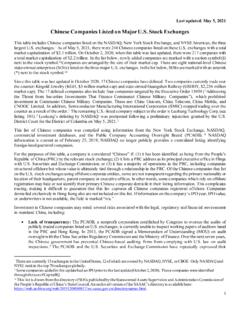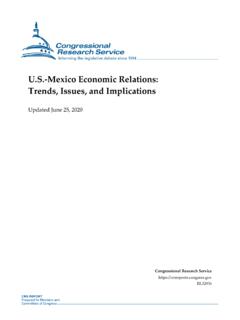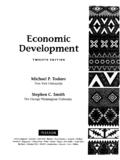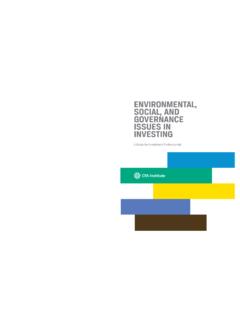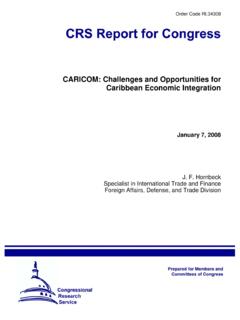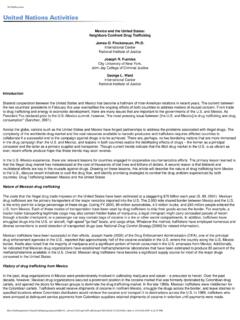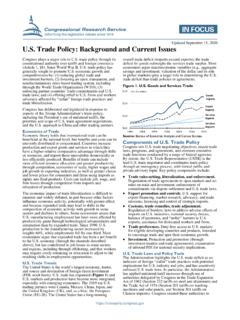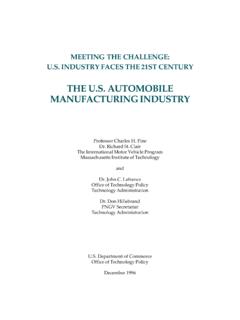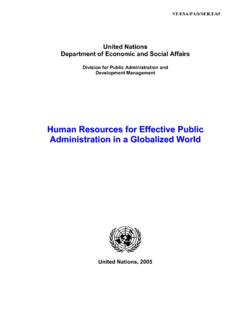Transcription of China’s Economic Ties with ASEAN: A Country-by-Country ...
1 March 17, 2015 Disclaimer: This paper is the product of professional research performed by staff of the Economic and Security Review Commission, and was prepared at the request of the Commission to support its deliberations. Posting of the report to the Commission s website is intended to promote greater public understanding of the issues addressed by the Commission in its ongoing assessment of Economic relations and their implications for security, as mandated by Public Law 106-398 and Public Law 108-7. However, the public release of this document does not necessarily imply an endorsement by the Commission, any individual Commissioner, or the Commission s other professional staff, of the views or conclusions expressed in this staff research report. Nargiza Salidjanova, Senior Analyst, Economics and Trade and Iacob Koch-Weser, Former Policy Analyst, Economics and Trade with Jason Klanderman, Former Research Intern China s Economic Ties with ASEAN: A Country-by-Country Analysis Economic and Security Review Commission Table of Contents Executive Overview of ASEAN-China Economic relations .
2 4 Trade ..4 Foreign Investment ..6 Future Prospects ..8 High-Income ASEAN Countries ..12 Brunei ..12 Singapore ..14 Middle-Income ASEAN Countries ..17 Indonesia ..17 Malaysia ..20 Thailand ..23 The Philippines ..25 Low-Income ASEAN Countries ..28 Vietnam ..28 Burma ..31 Cambodia ..34 Laos ..36 Note on Data ..39 Economic and Security Review Commission 3 Executive Summary The Association of Southeast Asian Nations (ASEAN) is a pillar of the postwar order in East Asia. Founded in 1967 by Indonesia, Malaysia, the Philippines, Singapore, and Thailand, principally to coordinate security policy during the Cold War, the bloc was significantly enlarged in the 1990s, when it took in low-income countries Burma (Myanmar), Cambodia, Laos, and Vietnam. At the height of the 1997 1998 Asian financial crisis, China and ASEAN forged a closer relationship. The two sides subsequently launched a currency swap initiative (the Chiang-Mai Initiative) and began negotiations on an ASEAN-China Free Trade Area (ACFTA), which entered into force in 2010.
3 Today, the complex relationship between China and ASEAN combines aspects of cooperation and tension. China s aggressive posturing in the South China Sea illustrates its increasing naval capabilities and willingness to deploy them, whether to secure offshore hydrocarbons and fisheries or to exact leverage over its smaller neighbors to the south. At the same time, China s rise exerts a powerful pull on ASEAN economies, from component manufacturing in Malaysia to banking in Singapore and copper mining in Burma. At once a manufacturing hub and an important source of capital, China has the potential to buoy the ASEAN economies, but also to create structural imbalances that damage the region in the long run. This paper assesses China s relative significance for individual ASEAN economies. It starts with an overview of China s trade and investment relations with ASEAN as a whole. The paper then provides descriptive statistics on each ASEAN country s composition of foreign trade by product and top trade partner, as well as foreign direct investment (FDI) flows.
4 It also provides a brief analysis of commercial disputes and bilateral cooperation with China. While each country s relationship with China is unique, trade and investment data reveal some noteworthy trends: China, the world s second-largest economy, consistently appears among the top five trade partners for ASEAN members. But the degree of dependence on China as a source of exports, imports, or both varies. Where wealthier ASEAN countries have a diverse set of trading partners, poorer ASEAN countries depend heavily on China, especially as a source of imports. Vietnam s share of Chinese export and import flows with ASEAN has increased substantially, while Singapore s share has dropped. Since full enactment of the ACFTA in 2010, ASEAN s goods trade with China has gone from surplus to a deficit that reached $45 billion in 2013. Thailand and Malaysia were the only countries that ran a goods trade surplus with China in 2013. The causal link between ASEAN s deficit and ACFTA merits scrutiny.
5 Manufactured goods, particularly machinery and electronics, are still a major source of ASEAN-China trade, illustrating the extent and durability of regional production networks. In terms of manufactures imports from China, Cambodia is the exception, due to its outsize reliance on Chinese textiles. On the export side, Indonesia and Burma are outliers, as their shipments to China are concentrated in fuels and minerals. Although its outbound direct investment has been rising rapidly, China is still marginal to ASEAN s overall FDI receipts. According to data from China s Ministry of Commerce (MOFCOM), China contributed a mere percent of ASEAN s total FDI inflows in 2013. FDI flows are also small relative to China s trade with ASEAN. ASEAN in 2013 accounted for percent of China s total trade, but only percent ($ billion) of China s global outbound investment stock. Even allowing for the possibility that MOFCOM may be undercounting actual flows (for example, by not factoring in investment originating in Hong Kong), the fact remains China is not yet a major investor in ASEAN.
6 Singapore, according to official statistics, is China s major FDI partner in ASEAN, making substantial direct investments into China ($ billion in 2013, or over 6 percent of the world total) and also receiving the lion s share of Chinese FDI to ASEAN (41 percent of stocks by the end of 2013). This likely overestimates actual flows, since Chinese companies may invest in ASEAN via subsidiaries in Singapore. Even so, it is clear that Singapore plays a unique role as a financial hub linking China to ASEAN, in lieu of mature capital markets in the rest of the region. Economic and Security Review Commission 4 Overview of ASEAN-China Economic relations Trade ACFTA is part of ASEAN s broader push toward signing preferential trade agreements outside the multilateral framework of the World Trade Organization (WTO), in line with the global proliferation of preferential trade agreements outside the WTO. ASEAN countries have signed dozens of individual free trade agreements (FTAs) within and beyond the Asia region, including with major economies in Europe and North America.
7 Over the past four years, ASEAN has led an initiative to combine five of its individual agreements (with Australia and New Zealand, China, India, Japan, and Korea, respectively) into the so-called Regional Comprehensive Economic Partnership (RCEP). RCEP negotiations were launched in November 2012, and are slated for completion by year-end 2015. Proponents of RCEP argue it could deepen Economic integration in Asia, the region that has been the focal point of global trade growth over the past decade. Detractors counter that RCEP, like ACFTA, is likely to be a shallow agreement amenable to ASEAN s heterogeneous member states, and as such will not make a major impact on regional Economic ties. RCEP excludes many of the advanced trade provisions promoted by the United States, such as those governing regulatory convergence, digital goods and services, and intellectual property. Skeptics also argue that despite China s official policy to defer to ASEAN as the leader in regional integration,1 China may come to dominate the development of RCEP.
8 Four ASEAN countries Brunei, Malaysia, Singapore, and Vietnam are party to the Trans-Pacific Partnership (TPP), a high-standard, mega-regional trade agreement the United States is negotiating with 11 other countries (including Australia, Canada, Chile, Japan, Mexico, New Zealand, and Peru) throughout the Asia Pacific TPP sets itself apart from RCEP in terms of the scope and depth of its provisions, and does not include China. Although TPP has many purposes, most of which are exclusively Economic , it could also have an indirect bearing on the balance of power in the Asia region, in terms of solidifying partnerships in the face of China s growing influence. The primary challenges to completing a meaningful TPP agreement are Japan s reluctance to open its agricultural sector and the failure of the Congress to pass a new Trade Promotion Authority (TPA) bill to grant the president fast-track negotiating authority. The majority ( percent) of ASEAN s trade in 2013 was with countries outside the bloc, a testament to the region s trade China was the largest individual trading partner (14 percent share of ASEAN trade), while the United States was the fourth largest ( percent share).
9 4 Several ASEAN members have established integrated supply chains with both China and Northeast Asia, largely as a function of China s emergence as the world s manufacturing and assembly hub. ASEAN s share of China s trade with the world has also been increasing (see Table 2). Although ACFTA suggests mutually beneficial Economic relations , the reality is that since full enactment of the agreement in 2010, ASEAN s goods trade with China has gone from surplus to a $45 billion deficit in 2013 (see Table 1). In terms of individual trade partners, it is notable that Vietnam s share of Chinese export and import flows with ASEAN has increased substantially over the past decade, while Singapore s share has dropped. Economic and Security Review Commission 5 Table 1: China s Bilateral Trade with ASEAN Countries (US$ billions) Source: China Ministry of Commerce, via CEIC database. 19982003200820131998200320082013 Exports10,919 30,935 114,139 244,133 100%100%100%100%Imports12,589 47,350 117,012 199,402 100%100%100%100%Balance(1,670) (16,415) (2,873) 44,731 100%100%100%100%Exports560 34 130 1,704 311 83 87 (277) 47 1,617 Exports3,901 8,873 32,325 45,886 ,226 10,486 20,092 29,969 (325) (1,613) 12,233 15,918 Exports1,172 4,482 17,210 36,947 ,462 5,754 14,387 31,479 (1,290) (1,272) 2,823 5,469 Exports1,594 6,142 21,383 45,941 ,675 13,998 32,131 60,068 (1,080) (7,856) (10,748) (14,128) Exports1,170 3,829 15,521 32,738 ,423 8,829 25,636 38,518 (1,253) (5,000) (10,116) (5,780) Exports1,499 3,094 9,088 19,836 6,309 19,508 18,205 (3,215) (10,420)
10 1,631 1,979 7,349 645 2,810 1,335 4,540 1,095 3,411 39 361 1,056 3,050 268 1,721 149 1,021 119 701 Exports1,024 3,180 15,139 48,599 1,455 4,343 16,886 1,725 10,797 31,714 US$ millionShare of ASEAN (%)High-IncomeLow-IncomeMiddle-IncomeMal aysiaThe PhilippinesSingaporeThailandVietnamASEAN TotalBruneiBurmaCambodiaIndonesiaLaos Economic and Security Review Commission 6 Table 2: China s Trade with ASEAN and the Rest of the World (US$ billions; share %) Source: China Ministry of Commerce, via CEIC database. Foreign Investment China is becoming a prominent outbound investor, making use of its large foreign exchange reserves and seeking to reduce its excessive levels of investment in the domestic market. Chinese global outbound investment flows grew from just over $34 billion in 2003 to $ billion in The combination of rising outbound FDI and a slowdown in foreign investment into China has led to a rapid reduction in China s net FDI surplus, from $46 billion in 2006 to $11 billion last At the same time, global FDI in ASEAN has been on the rise, increasing from just over $300 billion in 2003 to over $ trillion in 2013 (see Figure 1).

